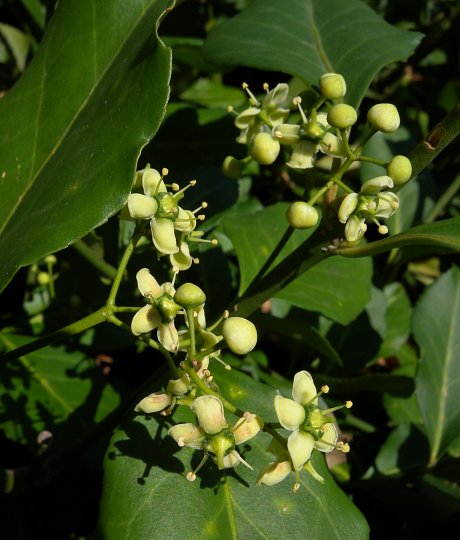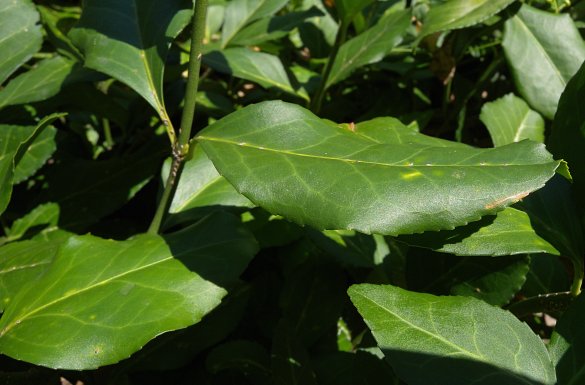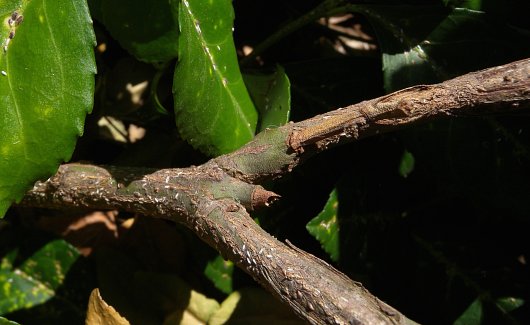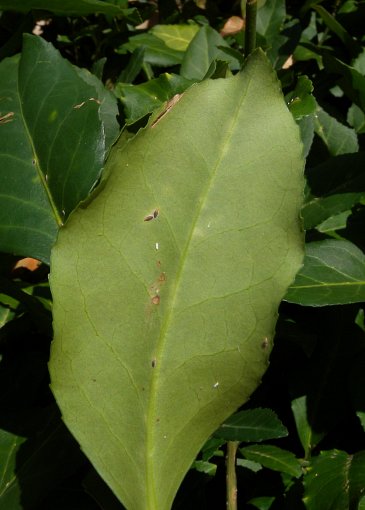
Flat-headed or dome-shaped clusters of flowers up to 3" across develop from the axils of mature leaves; their peduncles (basal stalks) are up to 4" long, while their pedicels are up to ½" long. Both peduncles and pedicels are light green, hairless, and terete. Each flower is about ¼" across, consisting of 4 greenish white petals, 4 green sepals, 4 spreading stamens, and a green pistil. The widely spreading petals are oblong-oval to oval in shape, convex along their upper surfaces, and concave along their lower surfaces; their margins are rolled upward. The sepals are very small, light green, glabrous, joined together at the base of the flower, and half-rotund in shape along their upper margins. The conspicuous stamens have white to light green filaments and white to pale yellow anthers. The blooming period occurs during the summer for about 3 weeks. Afterwards, fertile flowers are replaced by seed capsules that become mature during the autumn. Mature seed capsules are white, globoid, and about ¼" across. Eventually, they split open to reveal fleshy arils that are orange to red; solitary seeds occurs within these arils.

As a woody vine, this plant can form new rootlets when the nodes of its branches contact moist soil. In addition, when this vine climbs trees, it is able to produce aerial rootlets along its branches. The leaves of this woody plant are evergreen.
Cultivation: The preference is full sun to medium shade, moist to dry-mesic conditions, and soil containing loam, clay-loam, sand, and gravelly material. When light intensity is low, only immature leaves are produced unless this plant is able to climb an adjacent tree or wander into open ground where the light intensity is greater. After mature leaves are produced in response to sufficient intensity of light, both flowers and seed capsules can be produced. This vine can spread aggressively. It is winter-hardy to at least Zone 5.

Range & Habitat: So far, Climbing Euonymus (Euonymus fortunei) is relatively uncommon in Illinois as a naturalized plant (see Distribution Map). However, it is undoubtedly more common within the state than these records indicate. Climbing Euonymus was introduced into North America from East Asia as an ornamental landscape plant. It is often cultivated as a ground cover or shrub, even though it is potentially invasive of natural areas. In naturalized areas, this woody plant is often found in moist to mesic woodlands where deciduous trees are dominant. It also found at old homestead sites, edges of yards, vacant lots, park facilities, and stream terraces. Fire is not an effective method of control, because this evergreen woody plant is reluctant to burn and it is able to regenerate from its root system when fire-related damage occurs.
Faunal Associations: The only major insect pest of this woody plant is Unaspis euonymi (Asian Euonymus Scale). This insect sucks sap from the leaves and tips of young shoots. The colorful arils containing the seeds are probably eaten by various birds and distributed to new locations by them. White-tailed Deer and Cottontail Rabbits browse on the evergreen foliage of this woody plant, especially during the winter when little else is available (Zouhar, 2009).

Photographic Location: A garden bed at a bank in Urbana, Illinois.
Comments: There are many cultivars of Climbing Euonymus (Euonymus fortunei) that have been introduced as landscape plants. These cultivars vary from each other in such characteristics as leaf size, leaf shape, and habit of growth. At least one cultivar with variegated leaves exists, although it has not been observed to escape into the wild. Sometimes cultivars with larger leaves and a shrubby habit of growth are considered representatives of a distinct species, Euonymus kiautschovicus (Mohlenbrock, 2014). However, other authorities consider such cultivars as variants of the same species, Euonymus fortunei (see eFloras at www.efloras.org).